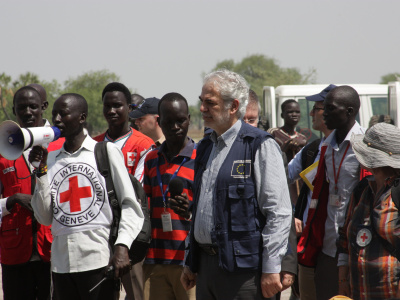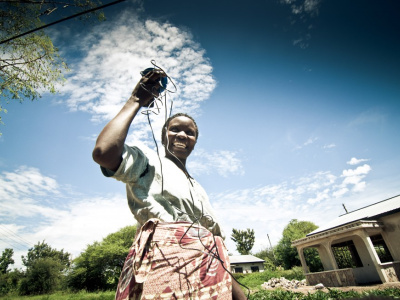
The European External Investment Plan and sustainable development - don't reinvent the wheel, just realign it
Addressing Africa’s infrastructure gap has become a key priority for development practitioners and policy-makers, but do the various initiatives align?
Addressing Africa’s infrastructure gap has become a key priority for development practitioners and policy-makers, and a ‘sine qua non’ condition for sustainable development on the continent. Reliable and efficient energy and transport infrastructures are urgently required to ease the costs (and time) of doing business, and thus attract firms and investments that can provide employment and income-generating opportunities.
That said, the amount of finance required for Africa’s appetite (and need) for hard and soft infrastructures far exceeds public resources, necessitating innovative financing approaches to tap private sector resources.
A number of different initiatives and instruments have recently emerged at the international and European levels to address this. Among these the most prominent is the European External Investment Plan (EIP), a strategy for building on previous EU blending activities.
The EIP three-pillar structure combination of financial (guarantee) and non-financial components (technical assistance and structured dialogue to improve the business environment) seems promising. But to go from policies and instruments to practice and impact, there is still some work to be done.
Understanding ‘the root causes’ of (un)sustainable blending activities
To really have an impact, the EIP will need to address some of the shortcomings that have limited sustainable private investments in the past. That suggests a need to take stock, study and discuss lessons learnt by development partners (such as the EIB, the World Bank or IFC) from past instruments such as the Investment Plan for Europe (IPE). Given that this is the basis for the EIP’s design, it might also inform EIP implementation. There, some of the lessons learnt include:
(1) Provide the right financial and administrative incentives to ensure proper uptake among relevant stakeholders. The evaluation of the EFSI (pillar one of the IPE) reveals that the pressure to reach the target of EUR 315bn of total investment pushed the EIB to focus on operations in markets that are more adept at using financial instruments and structuring high-risk projects. As a result, the EU15 received 92% of EFSI investments while the EU13 received only 8%. Incentives are therefore required to ensure that the EIP does actually invest in less or even least developed financial markets, thus leaving no African countries behind.
(2) Set up clear and effective additionality criteria while monitoring the sustainability of investments’ outcomes and impacts to ensure value for money. The additionality criteria of the EFSI regulation were found not to be explicit enough. As a result, some EFSI investments were questioned by stakeholders who indicated that as well as a need for EFSI to provide higher risk financing – the development impact has to be clear. In addition to more explicit criteria, these could also be made more comprehensive by integrating the creation of (decent) jobs within the additionality criteria, for example, which would reflect well the ambition of the EIP.
(3) Ensure complementarity between the different EIP pillars to build synergies and generate multiplier effects. The evaluation of the EFSI revealed that the complementarity between the EFSI pillars 2 (technical assistance) and 3 (on the regulatory environment) has been limited – notably because pillar 2 is too recent, and 3 has only made moderate progress to date. This lack of complementarity may be due to the multiplicity of actors (EC, EIB, EEAS) and their sometimes different interests. The EIP could draw on the World Bank Group’s approach and experience that combines both policy dialogue (World Bank), private sector financing (IFC), and political risks insurance (MIGA), as a way to leverage and identify developmental reforms dynamics.
To bring further coherence, cooperation and alignment in the field of ‘Financing for Development’, the EIP needs to build on and share lessons learnt, expertise, information and knowledge between relevant international and European actors.
These particularly include partner countries, International Finance Institutions, the EU member states, their development agencies, and respective development banks/DFIs. This way it would avoid ‘reinventing the wheel’, just as it did by building on existing EU blending instruments.
New announcement, and even more questions
While the EIP apparently offers one single coherent framework to stimulate sustainable investment, other initiatives have been launched in parallel: Germany announced its Marshall Plan for Africa, and, under its 2017 G20 Presidency, the G20 Compact with Africa, while at the same time Africa is being made a focus region for this year’s G20 agenda. Although these are laudable initiatives, the new announcements raise questions relating to how these will all align with the OECD’s development effectiveness agenda.
More specifically: How do these instruments fit with the principles of country ownership and Africa’s own initiatives and development plans, most notably with the African Union’s Agenda 2063? How does the EIP fit with, and build on, existing strategies and initiatives, such as the EIB operations in the ACP or the World Bank’s IFC-MIGA Private Sector Window in IDA 18? And, finally, how does the EIP relate to the other German-initiated plans, particularly the Marshall Plan with Africa?
To make the EIP more than ‘old wine in a new bottle’ will require bringing together these initiatives (and their underlying interests and drivers), while promoting the principles of coherence, efficiency, cooperation and equal partnership between Africa and the EU. Looking forward, it will therefore be key to analyse how these initiatives will land on the ground to promote peace, prosperity and sustainable solutions – and thus moving from policy to practice.
ECDPM is keen to support those efforts and will keep working on these highly relevant issues, with a view to providing independent and objective policy analysis, advice and dialogue facilitation.
The views expressed here are those of the authors and not necessarily those of ECDPM.





